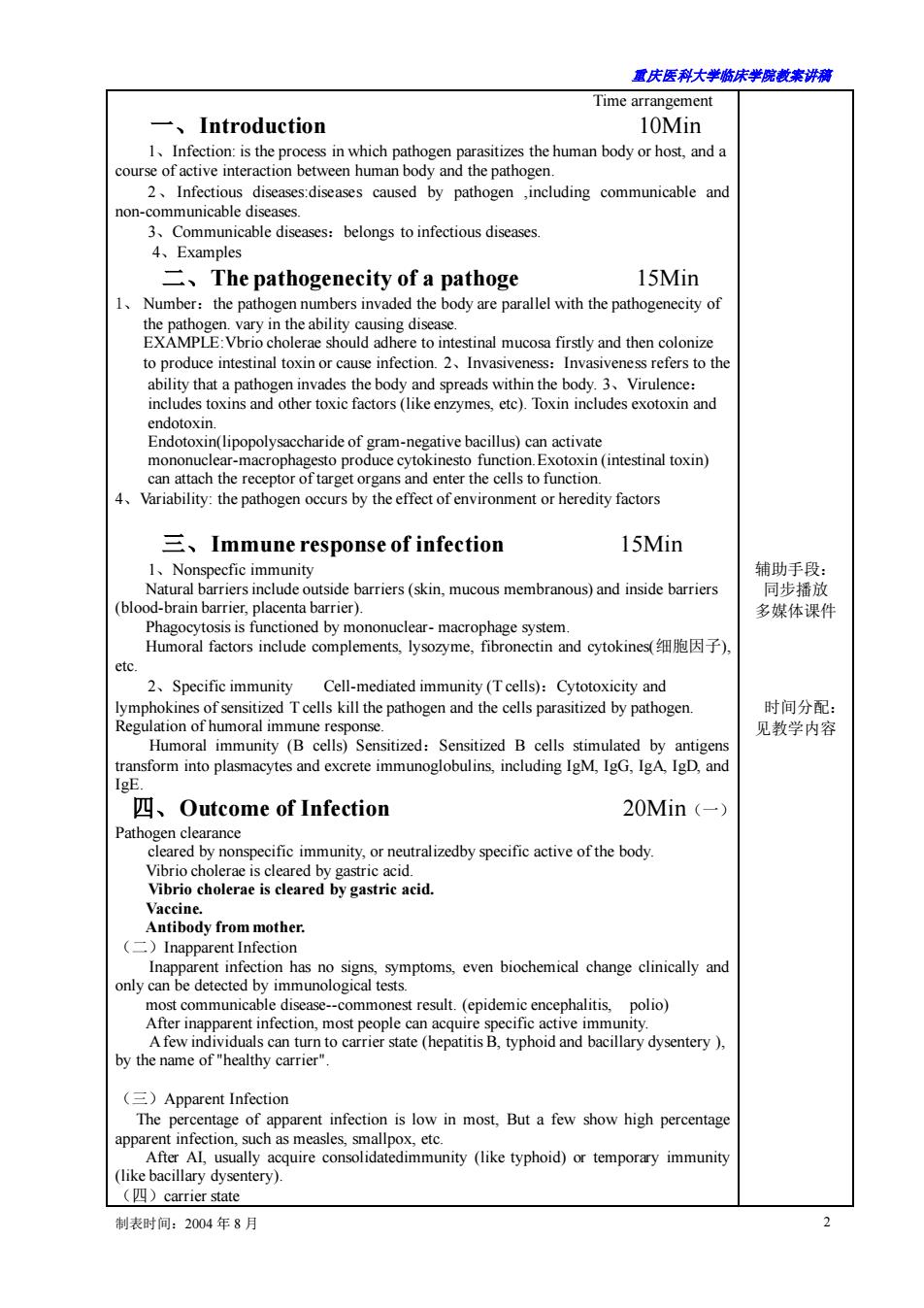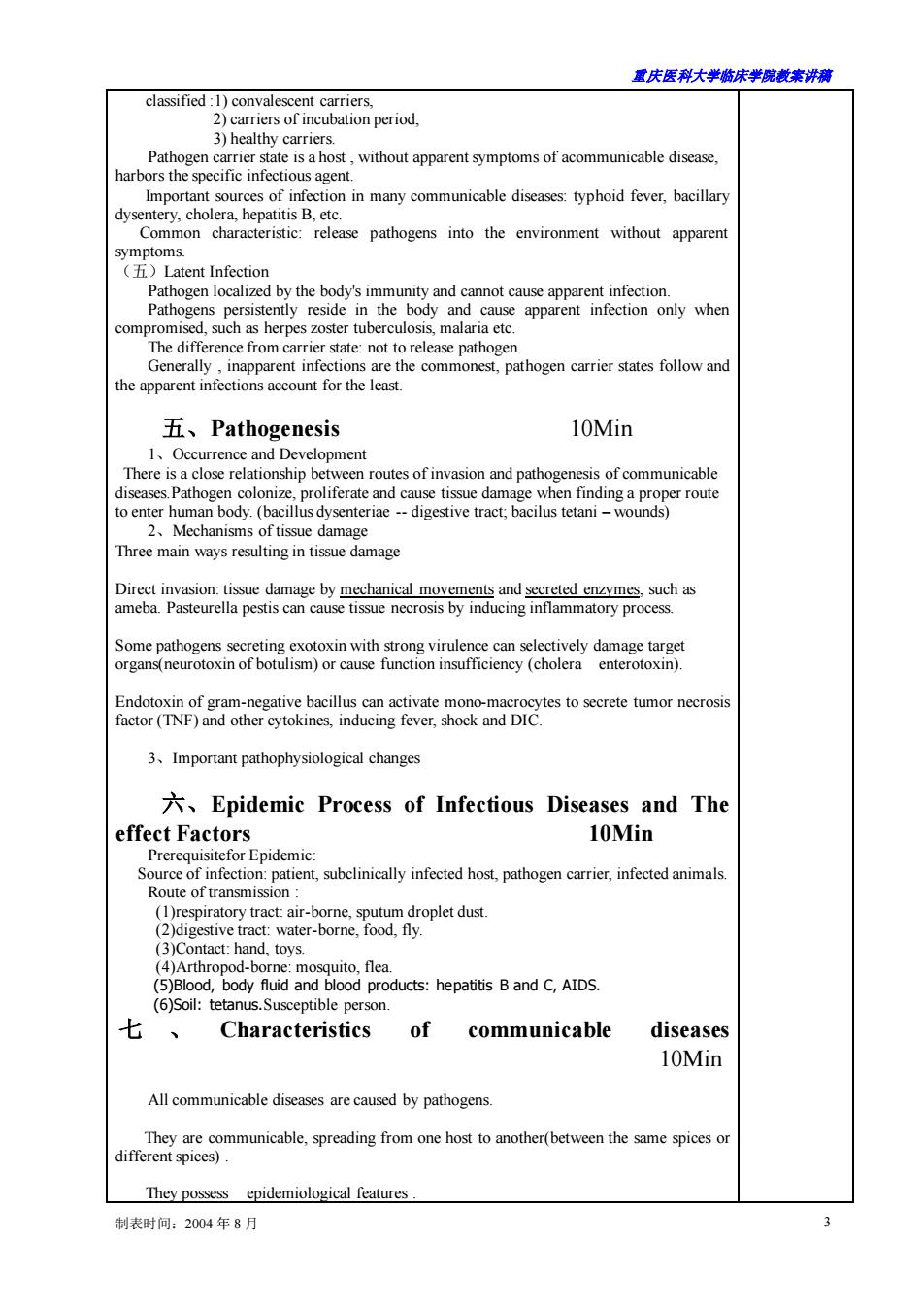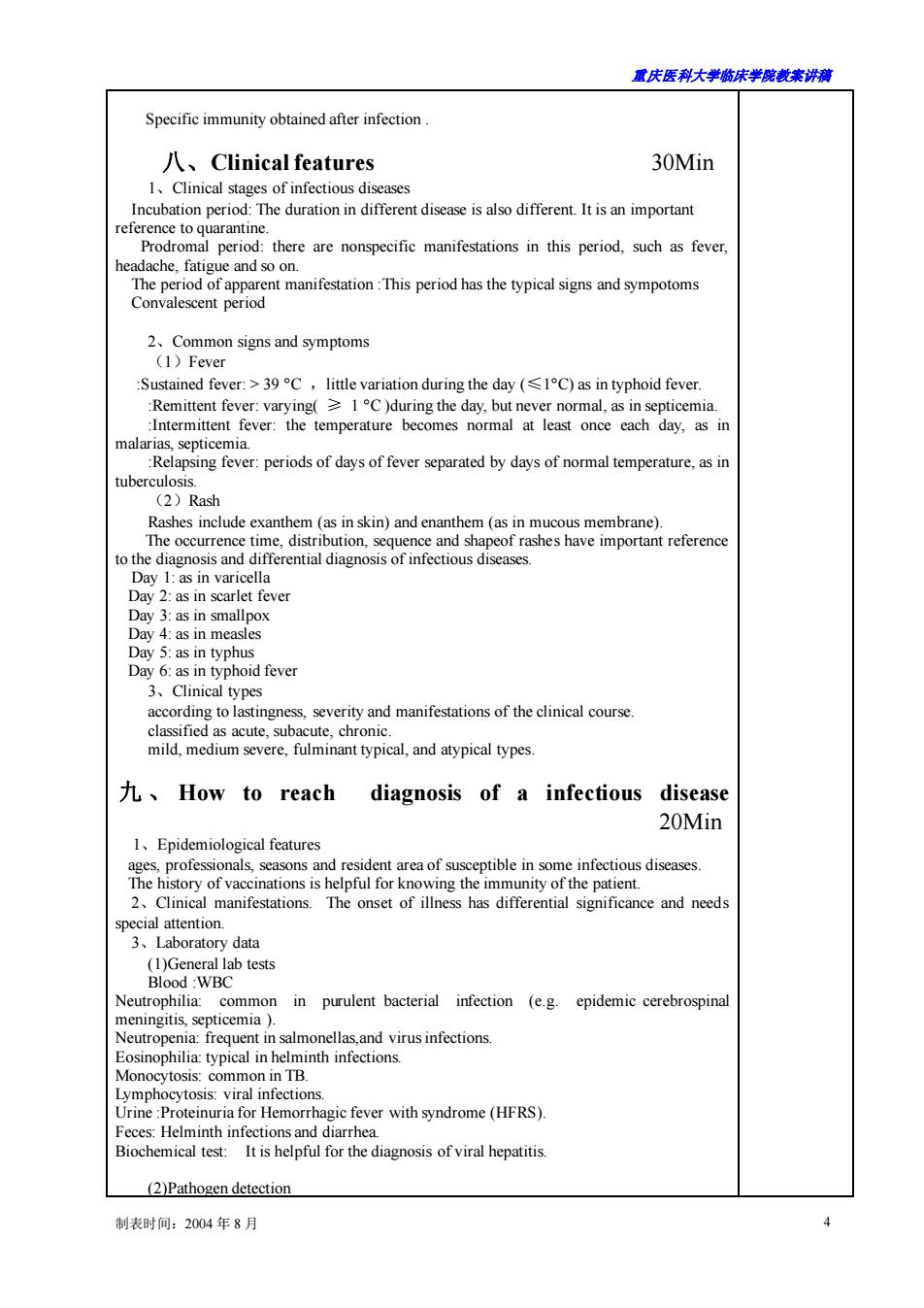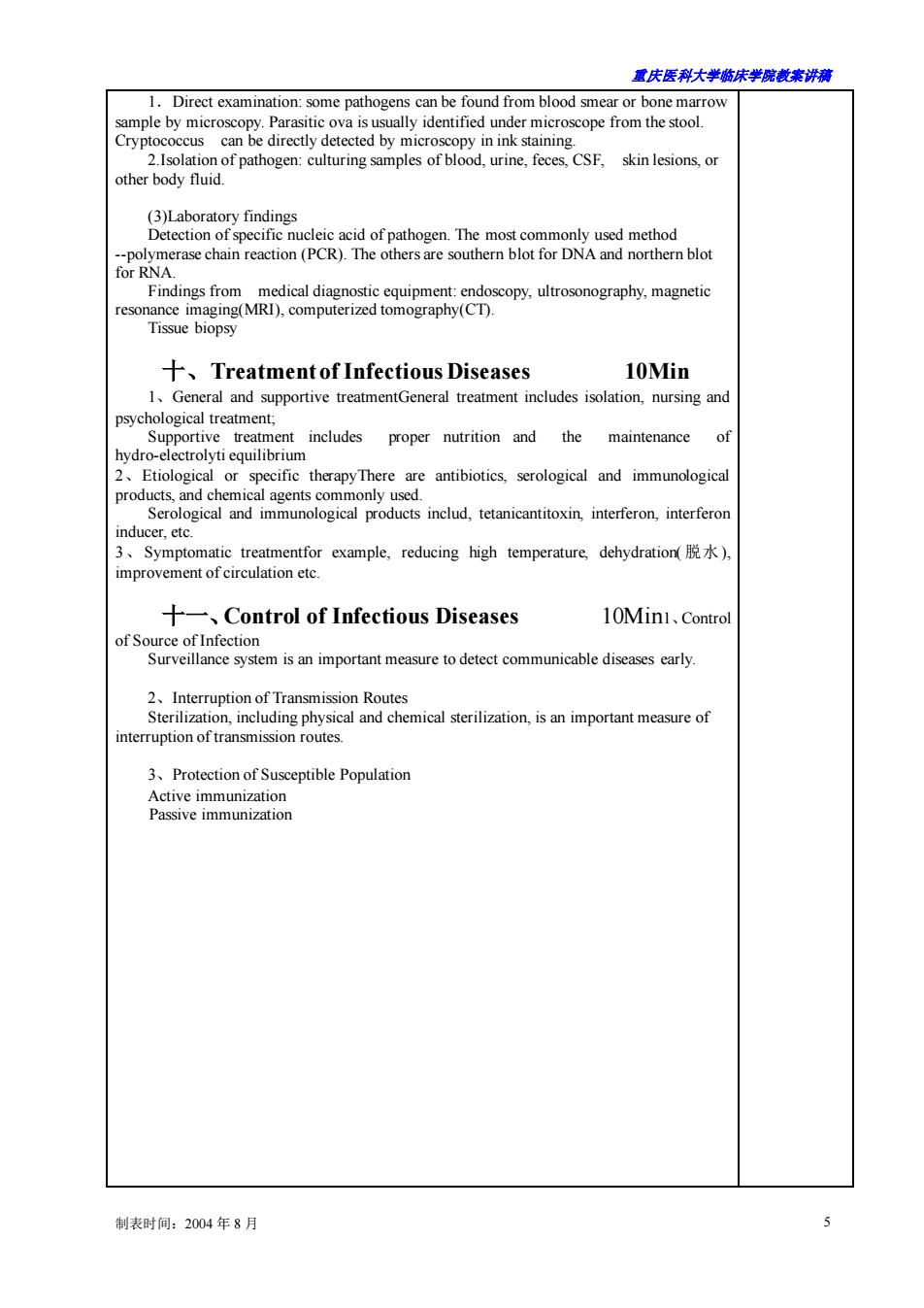
置庆医科大学脑床半院藏未讲满 重庆医科大学临床学院教案及讲稿 课程名称传染病学年级2004级授课专业 留学生 教师袁喆职称副教授授课方式 大课示教学时4 题目章节Part1 Introduction to Communicable Diseases 教材名称Lemology 作者 Chief Editor:LiuZhengwen 出版社of'a Jiaotong版次 2004.11 esisof infectious diseas 2.Epidemic Pro and The effect Factors 目的要 eatures of In ectious Disease 5.Treatment of Infectious Diseases 6.Control of Infectious Diseases 1.Epidemic Process and The effect Factors. 难 点 1.Epidemic Process and The effect Factors turesof us Diss 4.Treatment of Infectious Diseases 外语 要求 English Language 方过 Classroom lectures and multimedia 手段 115th Edition Mandell,Douglas and Bennett's Principales and Practice of Infectious Diseasea.Vol-2. 2001 edited by Gerald E.Bennett,Raphael Dolin,publishing by Harcourt Ansia and Churchill Livingstone. 见 教学组长: 教研室主任: 年 月 日 制表时间:2004年8月
重庆医科大学临床学院教案讲稿 制表时间:2004 年 8 月 1 重庆医科大学临床学院教案及讲稿 课程名称 传染病学 年级 2004 级 授课专业 留学生 教 师 袁 喆 职称 副教授 授课方式 √大课 示教 学时 4 题目章节 Part 1 Introduction to Communicable Diseases 教材名称 Lemology 作者 Chief Editor :Liu Zhengwen 出 版 社 Dean’s Office of Xi’an Jiaotong University 版次 2004 .11 教 学 目 的 要 求 1.Pathogenesisof Infectious Diseases 2.Epidemic Process and The effect Factors 3.Features of Infectious Disease 4.Diagnosis of Infectious Diseases 5.Treatment of Infectious Diseases 6.Control of Infectious Diseases 教 学 难 点 1.Epidemic Process and The effect Factors。 2.Pathogenesisof Infectious Diseases。 教 学 重 点 1.Epidemic Process and The effect Factors 2.Features of Infectious Disease 3.Diagnosis of Infectious Diseases 4.Treatment of Infectious Diseases 外语 要求 English Language 教学 方法 手段 Classroom lectures and multimedia 参考 资料 1、15th Edition Mandell,Douglas and Bennett’s Principales and Practice of Infectious Diseasea.Vol-2, 2001 edited by Gerald L.Mandell,Jone E.Bennett,Raphael Dolin, publishing by Harcourt Ansia and Churchill Livingstone. 2、4th Edition Kelley’s Textbook of Internal Medicine 2004 edited by H.David Humes, publishing by Lippincott Williams & Wilkins Inc. 教研 室意 见 教学组长: 教研室主任: 年 月 日

君庆医科大学脑床半院表来讲满 Time arrangement 一、Introduction 10Min the human body or host,and our 2 Infectious diseases:diseases caused by pathogen,including communicable and non-communicable diseases. 子、头ong 二、The pathogenecity of a pathoge 15Min l、Number:the nat vaded the body are parallel with the pathogenecity of nal toxin or cau infection.2.Invasivene Invasiveness refers to the endotoxin. ntehteomporoagtcgas97g2aigociSohmnmdiatoum 4.Variability:the pathogen occurs by the effect of environment or heredity factors 三、Immune response of infection 15Min unity ans水ecao时dst水ar 辅助手段: 同步播放 多媒体课件 2、Specific immunity Cell-mediated immunity(Tcells):Cytotoxicity and ed Tcells kill the pathogen and the cells parasitized by pathogen. m(Si Bmulted byanig gromnophamaotsandearcemigotdsmadeleMIgag入IeDmg 四、Outcome of Infection 20Min(-) Vibrio cholerae is cleared by gastric acid. (二)Inap e dane diicaly y the name of ()Apparent Infection The percentage of apparent infection is low in most,But a few show high percentage (四)carrier state 制表时间:2004年8月
重庆医科大学临床学院教案讲稿 制表时间:2004 年 8 月 2 Time arrangement 一、Introduction 10Min 1、Infection: is the process in which pathogen parasitizes the human body or host, and a course of active interaction between human body and the pathogen. 2、Infectious diseases:diseases caused by pathogen ,including communicable and non-communicable diseases. 3、Communicable diseases:belongs to infectious diseases. 4、Examples 二、The pathogenecity of a pathoge 15Min 1、 Number:the pathogen numbers invaded the body are parallel with the pathogenecity of the pathogen. vary in the ability causing disease. EXAMPLE:Vbrio cholerae should adhere to intestinal mucosa firstly and then colonize to produce intestinal toxin or cause infection. 2、Invasiveness:Invasiveness refers to the ability that a pathogen invades the body and spreads within the body. 3、Virulence: includes toxins and other toxic factors (like enzymes, etc). Toxin includes exotoxin and endotoxin. Endotoxin(lipopolysaccharide of gram-negative bacillus) can activate mononuclear-macrophagesto produce cytokinesto function.Exotoxin (intestinal toxin) can attach the receptor of target organs and enter the cells to function. 4、Variability: the pathogen occurs by the effect of environment or heredity factors 三、Immune response of infection 15Min 1、Nonspecfic immunity Natural barriers include outside barriers (skin, mucous membranous) and inside barriers (blood-brain barrier, placenta barrier). Phagocytosis is functioned by mononuclear- macrophage system. Humoral factors include complements, lysozyme, fibronectin and cytokines(细胞因子), etc. 2、Specific immunity Cell-mediated immunity (T cells):Cytotoxicity and lymphokines of sensitized T cells kill the pathogen and the cells parasitized by pathogen. Regulation of humoral immune response. Humoral immunity (B cells) Sensitized:Sensitized B cells stimulated by antigens transform into plasmacytes and excrete immunoglobulins, including IgM, IgG, IgA, IgD, and IgE. 四、Outcome of Infection 20Min(一) Pathogen clearance cleared by nonspecific immunity, or neutralizedby specific active of the body. Vibrio cholerae is cleared by gastric acid. Vibrio cholerae is cleared by gastric acid. Vaccine. Antibody from mother. (二)Inapparent Infection Inapparent infection has no signs, symptoms, even biochemical change clinically and only can be detected by immunological tests. most communicable disease-commonest result. (epidemic encephalitis, polio) After inapparent infection, most people can acquire specific active immunity. A few individuals can turn to carrier state (hepatitis B, typhoid and bacillary dysentery ), by the name of "healthy carrier". (三)Apparent Infection The percentage of apparent infection is low in most, But a few show high percentage apparent infection, such as measles, smallpox, etc. After AI, usually acquire consolidatedimmunity (like typhoid) or temporary immunity (like bacillary dysentery). (四)carrier state 辅助手段: 同步播放 多媒体课件 时间分配: 见教学内容

重庆医科大半脑床半院载未讲满 classified:1)convalescent carriers, period. Pathogenstaeisoswithout apparent symptoms ofacommunicableiss arbors the specific infe ou s agen Common characteristic:release pathogens into the environment without apparent Pathogen localized by the body's immunity and cannot cause apparent infection. The difference from carrier state:not to release pathogen leas 五、Pathogenesis 10Min evelopment tmbody (hacilusdvsenteriaedigestive tract.bacilus tetuniwoundser rout 2、Mechanism oftissue damage Some pathogens secreting exotoxin with strong virulence can selectively damage target organs(neurotoxin of botulism)or cause function insufficiency (cholera enterotoxin). Endotoxin of gram gative bacillus can activate mono-mac 3,Important pathophysiological changes Epidemic Process of Infectious Diseases and The effect Factors 10Min binically infeted hot.pahocn rer fml (1)respiratory tract:air-borne,sputum droplet dust. (e :water-borne,food,y (4)Arthropod-bo ne:mosquito,flea. (5B000, id an blood products:hepatitis Band C,AIDS. 七、 Characteristics of communicable diseases 10Min All communicable diseases are caused by pathogens. same spices They possess epidemiological features 制表时间:2004年8月
重庆医科大学临床学院教案讲稿 制表时间:2004 年 8 月 3 classified :1) convalescent carriers, 2) carriers of incubation period, 3) healthy carriers. Pathogen carrier state is a host , without apparent symptoms of acommunicable disease, harbors the specific infectious agent. Important sources of infection in many communicable diseases: typhoid fever, bacillary dysentery, cholera, hepatitis B, etc. Common characteristic: release pathogens into the environment without apparent symptoms. (五)Latent Infection Pathogen localized by the body's immunity and cannot cause apparent infection. Pathogens persistently reside in the body and cause apparent infection only when compromised, such as herpes zoster tuberculosis, malaria etc. The difference from carrier state: not to release pathogen. Generally , inapparent infections are the commonest, pathogen carrier states follow and the apparent infections account for the least. 五、Pathogenesis 10Min 1、Occurrence and Development There is a close relationship between routes of invasion and pathogenesis of communicable diseases.Pathogen colonize, proliferate and cause tissue damage when finding a proper route to enter human body. (bacillus dysenteriae - digestive tract; bacilus tetani – wounds) 2、Mechanisms of tissue damage Three main ways resulting in tissue damage Direct invasion: tissue damage by mechanical movements and secreted enzymes, such as ameba. Pasteurella pestis can cause tissue necrosis by inducing inflammatory process. Some pathogens secreting exotoxin with strong virulence can selectively damage target organs(neurotoxin of botulism) or cause function insufficiency (cholera enterotoxin). Endotoxin of gram-negative bacillus can activate mono-macrocytes to secrete tumor necrosis factor (TNF) and other cytokines, inducing fever, shock and DIC. 3、Important pathophysiological changes 六、Epidemic Process of Infectious Diseases and The effect Factors 10Min Prerequisitefor Epidemic: Source of infection: patient, subclinically infected host, pathogen carrier, infected animals. Route of transmission : (1)respiratory tract: air-borne, sputum droplet dust. (2)digestive tract: water-borne, food, fly. (3)Contact: hand, toys. (4)Arthropod-borne: mosquito, flea. (5)Blood, body fluid and blood products: hepatitis B and C, AIDS. (6)Soil: tetanus.Susceptible person. 七 、 Characteristics of communicable diseases 10Min All communicable diseases are caused by pathogens. They are communicable, spreading from one host to another(between the same spices or different spices) . They possess epidemiological features

君庆医科大学临床半院表来讲满 Specific immunity obtained after infection 八、Clinical features 30Min 1.Clinical stages of infectious diseases rethcRbeioaprindrnedrationindnierentdseaesadodificaentltisanimportamt rthere are opcife manifestations in this period,such as feve headache,fatigue and so on 2 Common sins and ympoms ring the da nc (2)Rash Rashes include exanthem(as in skin)and enanthem(as in mucous membrane). ere Day:s in varicella scarlet fever Day 4 as in measles ritad ifttion of hcinca 九、How to reach diagnosis of a infectious disease 20Min 1.Epidemiological features cs profeachelpfu forng h disase 2、story of ance and need special attention. 3、Laboratory data Neutronhilia common in purulent bacterial infection (e.g.epidemic cerebrospinal op hilia ty cytosis:comm morrhagic fever with syndrome(HFRS). Feces:Helminth infections and diarrhea Biochemical test:It is helpful for the diagnosis of viral hepatitis. (2)Pathogen detection 制表时间:2004年8月
重庆医科大学临床学院教案讲稿 制表时间:2004 年 8 月 4 Specific immunity obtained after infection . 八、Clinical features 30Min 1、Clinical stages of infectious diseases Incubation period: The duration in different disease is also different. It is an important reference to quarantine. Prodromal period: there are nonspecific manifestations in this period, such as fever, headache, fatigue and so on. The period of apparent manifestation :This period has the typical signs and sympotoms Convalescent period 2、Common signs and symptoms (1)Fever :Sustained fever: > 39 °C ,little variation during the day (≤1°C) as in typhoid fever. :Remittent fever: varying( ≥ 1 °C )during the day, but never normal, as in septicemia. :Intermittent fever: the temperature becomes normal at least once each day, as in malarias, septicemia. :Relapsing fever: periods of days of fever separated by days of normal temperature, as in tuberculosis. (2)Rash Rashes include exanthem (as in skin) and enanthem (as in mucous membrane). The occurrence time, distribution, sequence and shapeof rashes have important reference to the diagnosis and differential diagnosis of infectious diseases. Day 1: as in varicella Day 2: as in scarlet fever Day 3: as in smallpox Day 4: as in measles Day 5: as in typhus Day 6: as in typhoid fever 3、Clinical types according to lastingness, severity and manifestations of the clinical course. classified as acute, subacute, chronic. mild, medium severe, fulminant typical, and atypical types. 九 、 How to reach diagnosis of a infectious disease 20Min 1、Epidemiological features ages, professionals, seasons and resident area of susceptible in some infectious diseases. The history of vaccinations is helpful for knowing the immunity of the patient. 2、Clinical manifestations. The onset of illness has differential significance and needs special attention. 3、Laboratory data (1)General lab tests Blood :WBC Neutrophilia: common in purulent bacterial infection (e.g. epidemic cerebrospinal meningitis, septicemia ). Neutropenia: frequent in salmonellas,and virus infections. Eosinophilia: typical in helminth infections. Monocytosis: common in TB. Lymphocytosis: viral infections. Urine :Proteinuria for Hemorrhagic fever with syndrome (HFRS). Feces: Helminth infections and diarrhea. Biochemical test: It is helpful for the diagnosis of viral hepatitis. (2)Pathogen detection

置庆医科大半脑床半院未讲满 1.Direct examination:some pathogens can be found from blood smear or bone marrow other body fluid. p The momd n(PCR).The herorNohblt Findings from 十、Treatment of Infectious Diseases 10Min 2 Etiologicalor pecific therapyThere are and immunological proSsogchrandhologeaRodbcsnclud.ttanicantioinintafcronimarfeoa inducer,etc. 十一、Control of Infectious Diseases 10Minl、Contro emical ster isan important measure of nter 3.Protection of Susceptible Population 制表时间:2004年8月
重庆医科大学临床学院教案讲稿 制表时间:2004 年 8 月 5 1.Direct examination: some pathogens can be found from blood smear or bone marrow sample by microscopy. Parasitic ova is usually identified under microscope from the stool. Cryptococcus can be directly detected by microscopy in ink staining. 2.Isolation of pathogen: culturing samples of blood, urine, feces, CSF, skin lesions, or other body fluid. (3)Laboratory findings Detection of specific nucleic acid of pathogen. The most commonly used method -polymerase chain reaction (PCR). The others are southern blot for DNA and northern blot for RNA. Findings from medical diagnostic equipment: endoscopy, ultrosonography, magnetic resonance imaging(MRI), computerized tomography(CT). Tissue biopsy 十、Treatment of Infectious Diseases 10Min 1、General and supportive treatmentGeneral treatment includes isolation, nursing and psychological treatment; Supportive treatment includes proper nutrition and the maintenance of hydro-electrolyti equilibrium 2、Etiological or specific therapyThere are antibiotics, serological and immunological products, and chemical agents commonly used. Serological and immunological products includ, tetanicantitoxin, interferon, interferon inducer, etc. 3、Symptomatic treatmentfor example, reducing high temperature, dehydration( 脱水), improvement of circulation etc. 十一、Control of Infectious Diseases 10Min1、Control of Source of Infection Surveillance system is an important measure to detect communicable diseases early. 2、Interruption of Transmission Routes Sterilization, including physical and chemical sterilization, is an important measure of interruption of transmission routes. 3、Protection of Susceptible Population Active immunization Passive immunization